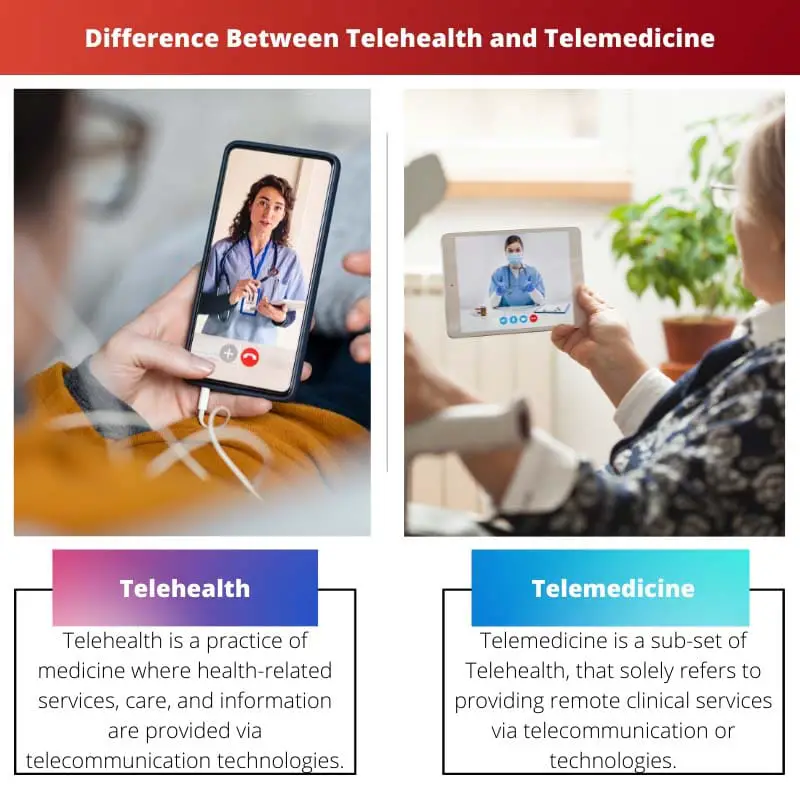Telehealth and Telemedicine are both practices of medicine using telecommunication technologies to provide medical services and care at a distance. The terms Telehealth and Telemedicine are used interchangeably. Though they are similar to each other in a lot of aspects, they have some notable differences between them.
Key Takeaways
- Telehealth is a broader term encompassing all healthcare services delivered remotely using technology, while telemedicine specifically refers to clinical services delivered remotely.
- Telehealth includes remote patient monitoring and healthcare education, while telemedicine includes virtual consultations and remote diagnosis.
- Telehealth can be used for non-clinical services like appointment scheduling, while telemedicine is used for clinical services only.
Telehealth vs Telemedicine
The difference between Telehealth and Telemedicine is how broad their scope of providing services is. Telehealth has a broader scope of providing remote health services than Telemedicine. This is because the term Telemedicine refers specifically to remote clinical services. Telehealth, on the other hand, refers to both remote clinical, as well as remote non-clinical services.

Telehealth is the practice of medicine using telecommunication technologies to provide medical services and care at a distance. Telehealth has a broader scope of providing remote health services, as it can refer not only to clinical services but also to non-clinical services.
Hence, besides providing clinical services, Telehealth also provides non-clinical services like administrative meetings, provider training, and the continuation of medical education.
Telecommunication is a practice of medicine using telecommunication technologies to provide clinical services and education at a distance. Telemedicine has a limited scope of providing clinical services than Telehealth.
This is because, Telemedicine solely provides remote clinical services, like medication management and specialist consultation, via secured video and audio recordings.
Comparison Table
| Parameters of Comparison | Telehealth | Telemedicine |
|---|---|---|
| Definition | Telehealth is a practice of medicine where health-related services, care, and information are provided via telecommunication technologies. | Telemedicine is a sub-set of Telehealth, that solely refers to providing remote clinical services via telecommunication technologies, or electronic software. |
| Spectrum | Telehealth has a broader spectrum of providing healthcare services, as it not only refers to providing clinical services but also non-clinical services. | Telemedicine has a limited spectrum as it solely refers to providing remote clinical services. |
| Non- clinical services | Besides providing remote clinical services, Telehealth also provides remote non-clinical services. | Telemedicine solely provides remote clinical services. They do not provide non-clinical services. |
| Services provided | Telehealth not only provides clinical services, like ECG, virtual appointments, remote diagnoses, e-prescriptions but also non-clinical services like administrative meetings, provider training, and the continuation of medical education. | Telemedicine solely provides clinical services like medication management, specialist consultation via secured videos and audio recordings. |
| Classification | All Telehealth is not Telemedicine. | All Telemedicine is Telehealth. |
What is Telehealth?
Telehealth is a practice of medicine where health-related services, care, remote clinical, as well as non-remote clinical services are provided via telecommunication technologies. The main purpose of this service is to improve the healthcare delivery system as a whole.
Telehealth is a broader scope of providing remote healthcare services. Telehealth not only refers to providing remote clinical services but also remote non-clinical services.
Telehealth is a sub-set of E-health, which provides healthcare services, health information, education, and training of health workers through the internet and other telecommunication technologies.
Telehealth provides remote clinical services like ECG, virtual appointments, remote diagnoses, e-prescriptions, remote medical consultations, and checking of blood pressure.
Besides providing clinical services, Telehealth also provides non-clinical services like administrative meetings, provider training, and the continuation of medical education for healthcare workers.

What is Telemedicine?
Telemedicine is a sub-set of Telehealth. Telemedicine provides solely remote clinical services via electronic software and telecommunication technologies. The main purpose of this service is to improve the healthcare delivery system as a whole.
Telemedicine has a limited scope of providing remote healthcare services. Unlike Telehealth, which provides both clinical and non-clinical services, Telemedicine solely provides remote clinical services.
This also implies that all Telehealth is not Telemedicine. However, all Telemedicine is Telehealth.
Telemedicine provides clinical services to patients who are not able to have an in-person visit with the Doctors.
They provide clinical services like medication management, specialist consultation, follow-up visits, and chronic disease management via secured videos and audio recordings. Telemedicine is an extremely budget-friendly means of receiving healthcare services.

Main Differences Between Telehealth and Telemedicine
- Telehealth is a subset of E-health, whereas Telemedicine is a subset of Telehealth.
- Telehealth has a broader spectrum than Telemedicine of providing healthcare services via the Internet, whereas Telemedicine has a limited spectrum of providing healthcare services.
- All Telehealth is not Telemedicine. However, all Telemedicine is Telehealth.
- Telehealth provides both remote clinical, as well as non-clinical services, whereas Telemedicine solely provides remote clinical services via the internet.
- Telehealth provides not only clinical services, like ECG, virtual appointments, remote diagnoses, and e-prescriptions, but also non-clinical services, like administrative meetings, provider training, and the continuation of medical education. On the other hand, Telemedicine solely provides clinical services like medication management and specialist consultation via secured videos and audio recordings.
- Telehealth can be used in a general healthcare service, whereas telemedicine deals with specific clinical services providing a different form of healthcare service.
- Telehealth can provide different forms of diagnosis, management and education, whereas Telemedicine refers to traditional technologies providing medical diagnosis and screening.

- https://doi.org/10.1017/S0963180108080535
- https://www.liebertpub.com/doi/abs/10.1089/tmj.2006.12.128




